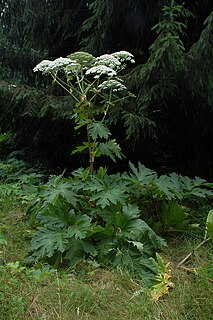
Heracleum mantegazzianum, commonly known as giant hogweed, is a monocarpic perennial herbaceous plant in the carrot family Apiaceae. H. mantegazzianum is also known as cartwheel-flower, giant cow parsley, giant cow parsnip, or hogsbane. In New Zealand, it is also sometimes called wild parsnip or wild rhubarb.

Note that information on this species applies to Western Europe and some details may not be consistent with the species in other parts of its range.

Apamea crenata, known as the clouded-bordered brindle, is a moth in the family Noctuidae. It is distributed throughout the Palearctic realm. In the North it crosses the Arctic Circle, in the Mediterranean it is found only in cool locations and mountains avoiding very hot areas. In the Alps, it rises to an altitude of about 2000 metres.

Colias chrysotheme, the lesser clouded yellow, is a small Palearctic butterfly belonging to the family Pieridae.

Leucodonta bicoloria, the white prominent, is a moth from the family Notodontidae. It ranges from Western Europe (Ireland) to Hokkaido (Japan) being found in the northern part of Middle Europe, Northern Europe and Russia to the Amur region. In the western parts of the range it is a local and rare species. It is likely extirpated in Britain but a population was recently rediscovered in Ireland. The habitat requirements of the species are a bit unusual, it seems to prefer locally warm deciduous and mixed forests, where birch, the sole host plant, forms the canopy (except Japan. The moth survives winter as a pupa underground.
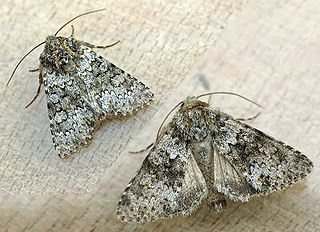
Hecatera dysodea, the small ranunculus, is a moth of the family Noctuidae. It is found in Europe, primarily in Central Europe and Southern Europe The northern boundary of the distribution is from the Baltic Sea and the southern part of Lithuania, Belarus, south of Moscow to the Urals. North Africa forms the distribution border in the south east they extend to the Middle East, Turkestan and across the Palearctic to Central Asia. It is an introduced species in North America, where it was first found in Utah in 1998 and Oregon in 2005.

Acleris variegana, the garden rose tortricid moth or fruit tortricid, is a moth of the family Tortricidae. It has a Palearctic distribution. The moth flies from July to September mainly at night and is attracted to bright lights. The larvae feed on various trees and shrubs including rose and apple.

Drepana falcataria, the pebble hook-tip, is a moth of the family Drepanidae. The species was first described by Carl Linnaeus in his 1758 10th edition of Systema Naturae. It is found in Europe, through Siberia to the eastern Palearctic.

Morophaga choragella is a moth of the family Tineidae. It is found in Europe.

Euleia heraclei, known as the celery fly or the hogweed picture-wing fly is a species of tephritid or fruit flies in the genus Euleia of the family Tephritidae.
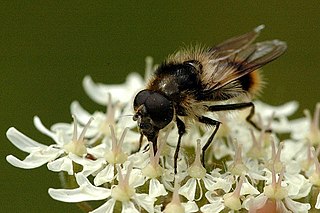
Cheilosia illustrata is a species of hoverfly belonging to the family Syrphidae.
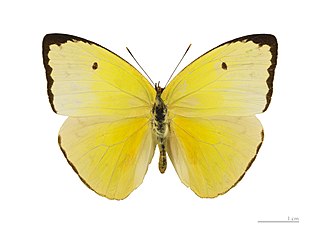
Aphrissa statira, the statira sulphur, is a species of Lepidoptera in the family Pieridae. The species is a medium-sized yellow butterfly, with females more pale than males. They are found from southern regions of Florida and Texas through southern Brazil and northern Argentina. The caterpillars feed on the leaves of several local host plants, while adults prefer to feed on the nectar of red or orange colored flowers. The species is most noted for their dramatic migrations in the tropical areas of the Americas. They have been the subject of many studies about how butterflies navigate and orient during migration.
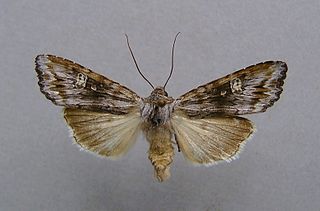
Lithomoia solidaginis, the golden-rod brindle, is a moth of the family Noctuidae. The species was first described by Jacob Hübner in 1803. It is found in most of Europe, except the Iberian Peninsula, Ireland, Iceland and the western and southern part of the Balkan Peninsula. Then eastwards to the Urals, Kamchatka and Japan.In the Alps it rises to about 1500 meters. It is found mainly on marshy ground, in humid mixed forests as well as in tundra - and taiga areas.

Gesonia obeditalis is a species of moth of the family Noctuidae first described by Francis Walker in 1859. It is found from eastern Africa, the Seychelles, the Maldives and the Oriental tropics of India, Sri Lanka east to the Philippines, the Sula Islands and Australia. The adult moth has brown wings with a scalloped dark brown band near the margin. The hindwings are similar in pattern to the forewings but are a paler shade of brown.

Epermenia chaerophyllella, also known as the garden lance-wing, is a moth of the family Epermeniidae first described by Johann August Ephraim Goeze in 1783. It is found in all of Europe and Asia Minor.
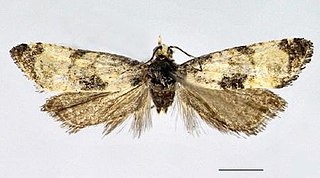
Cochylis dubitana, the little conch, is a moth of the family Tortricidae. It is found in China (Heilongjiang) and most of Europe. and the Caucasus. It is also found in North America, where it has been recorded from Colorado, Maine, Ontario and Washington.

Phaulernis dentella is a moth of the family Epermeniidae found in Asia and Europe. The moth was first described by Philipp Christoph Zeller in 1839.

Phaulernis fulviguttella, the yellow-spotted lance-wing, is a moth of the family Epermeniidae found in the Palearctic including Europe.

Asaphodes beata is a species of moth in the family Geometridae. It is endemic to New Zealand and is a relatively common species that can be found throughout the country in native forest or scrub habitat. It can be distinguished from its close relative Asaphodes adonis by the colour of its hind wings. The larvae of this species feeds on watercress but tends to be inactive during the day. If threatened it will mimic a twig dropping to the ground. The adult moths are on the wing from October to March and are said to be attracted to white rātā. The white markings on the forewing of the adults are variable in appearance.

Austramathes purpurea is a species of moth in the family Noctuidae. It is endemic to New Zealand and can be found throughout the North and South Islands but has yet to be recorded at Stewart Island. It inhabits native forest. This species might possibly be confused with A. pessota, however this latter species does not have the purple hue to the forewings. The larvae of A. purpurea feed primarily on māhoe but have been recorded as feeding on, and have been reared on, narrow-leaved māhoe. The larvae pupate in a silken cocoon on moss covered ground. Adults can be found on the wing during the months of March to January but mainly occur during New Zealand's late autumn, winter, and spring. Light trapping may not be the most efficient technique for collecting this species.





















